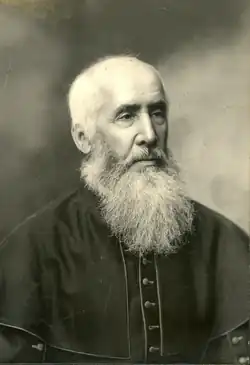Joseph Buh
Monsignor Joseph Buh | |
|---|---|
 | |
| Church | Catholic Church |
| Diocese | Duluth |
| Orders | |
| Ordination | 1858 |
| Personal details | |
| Born | March 17, 1833 Lučine, Austria |
| Died | February 2, 1922 (aged 88) |
| Buried | Calvary Cemetery, Duluth |
Joseph Francis Buh (/buː/ BOO;[1] March 17, 1833 – February 2, 1922) was a Slovene Catholic missionary priest who has been called the "Patriarch of the Diocese of Duluth".[1]
Early life
Joseph Francis Buh was born on March 17, 1833, in Lučine, Carniola, Austria (modern day Slovenia) to Mathias Buh and Maria Kosir. He was ordained to the priesthood in 1858, at the age of 25, in Ljubljana. He served as a priest in the Municipality of Loški Potok for two years before being transferred to Radeče. After expressing an interest in missionary work, Buh was contacted by Francis Xavier Pierz about the possibility. They embarked at Le Havre, France on April 10, 1864, for New York.[2][3] Frederick Katzer and James Trobec were on the same ship.[2]
Missionary work
Buh arrived in St. Paul in April 1864, and settled in Crow Wing County. Not long after, he moved to Belle Prairie, near Lake Winnibigoshish, and began working among the indigenous people as a missionary.[3] Within a several months, Buh learned the Ojibwe language.[4] He eventually settled in Perham. The Vicariate of Northern Minnesota was established in 1875, and the Diocese of Duluth was established from that territory in 1889. Buh, at the time ministering to Slovenes in Northern Minnesota, was called upon by Bishop James McGolrick to be his vicar general. Together with another Slovene priest, Francis X. Bajec, he established a miner's union.[3] He made two trips back to Europe as a priest, first in 1870 which included a visit to the Holy Land and the second in 1883 for his silver jubilee. On both occasions, he returned with missionary seminarians.[2]
Buh was fond of working with Native Americans, and spoke out for their well-being.[3] He was given the names by the Chippewa: "Little Book" (Ojibwe: Masinaigans) and "Long Beard" (Ojibwe: Meshidong).[5][6] He was the first to hold Catholic religious services at White Earth.[2]
In 1888, he took up residence in Tower, Minnesota. During his time in residence there, he built churches in Two Harbors, Ely, and Virginia[2]
Buh helped establish over 50 parishes in the Diocese of Duluth.[1] In 1899, he was named a Domestic Prelate of His Holiness by Pope Leo XIII.[3] A ceremony conferring the title took place at the cathedral of Duluth on December 27, attended by Archbishop John Ireland, Bishop Joseph Bernard Cotter, Bishop John Shanley and Bishop James Trobec.[2]
Death
Buh died on February 2, 1922, after having fallen ill several days prior and receiving Last Rites on February 1.[3][7] He was interned at Calvary Cemetery in Duluth.[3] At his funeral Mass, Bishop Timothy McNicholas stated he had an "extraordinary zeal" and that "no journey on foot, no distance by horseback was too long or too trying provided a soul was to be helped at the journey’s end";[1] McNicholas went on to call him a "saintly priest", a "hunter of souls", and "fisher of men".[8]
Legacy

After his death, holy cards with a picture of Buh and containing clippings from a shirt of his were distributed by religious sisters. While there were signs of devotion to him, no formal cause for canonization was initiated at that time.[9] Buh Township in Morrison County, Minnesota, was named after him.[10]
In the fall of 2023, the bishop of Duluth, Daniel Felton, began discussing a cause for canonization for Buh with local clergy.[1][9] His body was exhumed on July 25, 2024, and reinterred in the Cathedral of Our Lady of the Rosary in Duluth on June 10, 2025.[9][8]
References
- ^ a b c d e Pinedo, Peter (August 28, 2024). "Meet Msgr. Joseph Buh, the Duluth Priest Who Could Become America's Next Saint". National Catholic Register. Archived from the original on June 10, 2025. Retrieved June 10, 2025.
- ^ a b c d e f "Father Buh Receives the Insignia of Monseignor Extended by Leo XIII". Duluth Evening Herald. December 27, 1899. p. 8. Retrieved June 10, 2025 – via Minnesota Historical Society.
- ^ a b c d e f g "Monsignor Joseph Francis Buh". Tower Soudan Historical Society. December 27, 2023. Archived from the original on April 22, 2025. Retrieved June 10, 2025.
- ^ Singerton, Jonathan (2025). "Myriad Missions: Native Americans and the Leopoldine Society". Habsburg Encounters with Native America. Central European University Press. pp. 157–180. ISBN 9789048571802. Retrieved July 21, 2025.
- ^ Coleman, Bernard; LaBud, Verona (1972). Masinaigans-The Little Book: A Biography of Monsignor Joseph F. Buh, Slovenian Missionary in America, 1864-1922. Saint Paul, MN: North Central Publishing Company. p. iv.
Masinaigans (pronounced: mah-sin-aýe-gahns) is the name (one of two) by which the Indians called Father Buh. They seldom saw him without a little book in his hand — no doubt, his ordo and/or/breviary.
- ^ Coleman & LaBud 1972, p. 238: "To [the Indians] Buh was affectionately called Meshi-dong (the Beard, the Long Beard, or the Bearded One)."
- ^ "Vicar General Reported Dying". The Daily People's Press. Owatonna, Minn. Associated Press. February 2, 1922. Retrieved June 10, 2025 – via Minnesota Historical Society.
- ^ a b Lawler, Christa (June 10, 2025). "Exhumed Duluth priest gets new resting place as supporters start push toward sainthood". Star Tribune. Archived from the original on June 10, 2025. Retrieved June 10, 2025.
- ^ a b c Lawler, Christa (August 27, 2024). "Long-dead Duluth priest's body exhumed to begin winding path to sainthood". Star Tribune. Archived from the original on August 27, 2024. Retrieved June 10, 2025.
- ^ Upham, Warren (1920). Minnesota Geographic Names: Their Origin and Historic Significance. Minnesota Historical Society. p. 351.